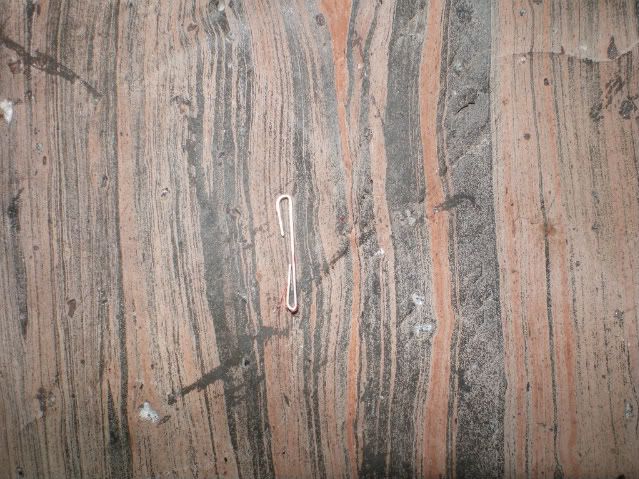Happy Weekend everyone!
Because the title of my blog is “Chaotically Flow-Banded,” I think its high time that I blog about, you know, flow banding! Flow banding is a pervasive feature that can be found in many different lava flows and domes throughout the world. Because of this fact, they can often be used to characterize the internal structure of many different lava flows as they extruded and then solidified. In other words volcanologists can use flow bands much like how structural geologists use sedimentary successions and metamorphic fabrics to help characterize regional deformation patterns.
But what are flow bands? Simply put, flow bands are rhythmically sequenced "layers" which are distinct compared to adjacent "layers". Flow bands can vary in thickness on scales from a few microns to 10s of centimeters. Banding can be defined in many different ways, however most are not defined by distinct compositional changes between bands, but instead by texture or oxidation states. For example, at Obsidian Dome, where I am currently completing a thesis, flow bands are chiefly defined by microlite densities (see figure below). In other flows like the Mayor Island flow in New Zealand, flow banding is defined by vesicularity (see fig. 5 in Gonnermann and Manga, 2005).
Photomicrograph showing microlite-defined, horizontally-oriented flow banding. Darker bands are denser in microlites. 10x magnification. Brownish feature on right is a spherulite.
Flow-banding is perhaps one of my favourite things to look at in the field and in hand sample – especially when it gets deflected around phenocrysts, as this is beautifully shown below.
Close-up photo of spectacularly flow-banded obsidian from Obsidian Dome as accentuated by surficial weathering of iron oxide (likely from the microlite-rich bands of ferromagnesian minerals). Staple is ~1 cm wide. To the right of the lower staple hook, flow bands are deflected by a phenocryst.
Have a great weekend, and please comment!
Reference:
Gonnermann, H. M. and Manga, M., 2005, Flow banding in obsidian: A record of evolving textural heterogeneity during magma deformation. Earth and Planetary Science Letters, 236 (1-2), p. 135-147.
All photos (c) 2010 by Cole Kingsbury



So, what is a microlite? (Wikipedia is not proving very succinct in answering this question.)
ReplyDeleteThis explains a sample I couldn't figure out - it's obsidian with oxidized, vesicular bands. Thanks :)
A microlite is any crystal (though predominately feldspar, hornblende and pyroxene) within a volcanic rock that is less than 0.1 mm in size. Because of the this fact, individual microlites typically can only be seen under a petrographic microscope. Most of the microlites in my study area (Obsidian Dome) are shaped like rods or chains, and are aligned parallel to the flow banding.
ReplyDeleteThanks for your response and your question!
~Cole K.
Ola Cole,
ReplyDeletethanks for the enlightenment and the reference. It is just what I needed to figure out the flow mechanics for flow-banded obsidian from the Teklanika formation. Hope you are doing well!
All the best,
Susi T.